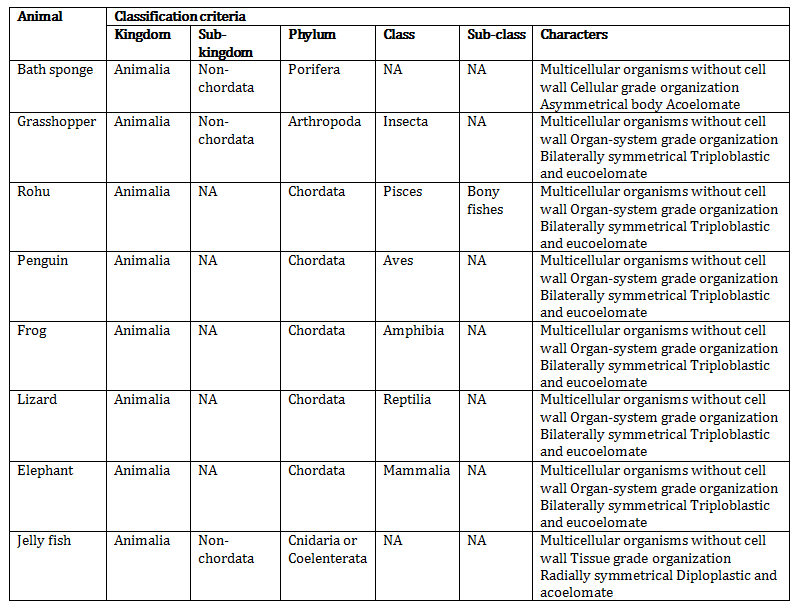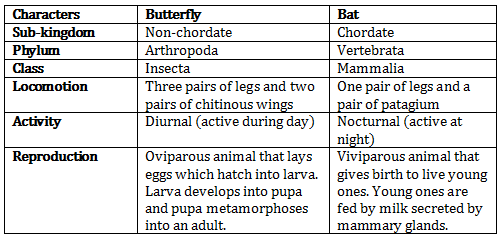Class 10 MAHARASHTRA STATE TEXTBOOK BUREAU Solutions Science Chapter 6 - Animal Classification
Animal Classification Exercise Exercise
Solution 1
- Phylum Cnidaria or Coelenterata
- Phylum Echinodermata
- Phylum Aschelminthes
- Phylum Porifera
Solution 2

Solution 3
Several methods of classification of animals were put forth by different scientists.
- The first classification method was given by the Greek philosopher Aristotle. He took into account criteria like body size, habits and habitats of the animals. This method was called artificial method of classification.
- The same artificial method was used by other scientists like Theophrastus, Pliny, John Ray and Linnaeus.
- Further, due to advances in science, the references were changed and some new methods of classification were proposed.
- The system of classification called 'Natural system of classification' was proposed. This classification system was based on the criteria such as body organization, types of cells, chromosomes and bio-chemical properties.
- Later, Dobzhansky and Meyer gave the system of classification based on evolution.
- In 1977, Carl Woese has also proposed the three-domain system of animal classification.
Solution 4
I. Grades of organization: Grade of organization refers to the levels in which cells are arranged. It shows the way in which body formation occurs in an organism.
- Unicellular organisms like amoeba have a single cell in their body and hence the body organization is called protoplasmic grade of organization.
- Some organisms have only cells in their body which is called cellular grade of organization, e.g. Poriferans.
- Some organisms have tissues in their body e.g. Coelenterates. They are said to have tissue grade organization.
- Some organisms have organs in their body, they are said to have organ grade organization, e.g. Platyhelminthes. All higher animals have organ-system grade organization.
II. Symmetry: Symmetry shows the base of body formation. Symmetry can be understood by taking an imaginary cut through the animal body. There are three types of body symmetry:
- Asymmetrical Body: In case of such body, there is no any such imaginary axis of the body through which we can get two equal halves. Ex. Amoeba, Paramoecium, some sponges.
- Radial symmetry: In this type of body, if imaginary cut passes through central axis but any plane of body, it gives two equal halves. Ex. Star fish.
- Bilateral symmetry: In this type of body, there is only one such imaginary axis of body through which we can get two equal halves. Ex. Insects, fishes, frog, birds, human, etc.
- Both grades of organization and symmetry are the basis for classifying animals into different phyla.
Solution 5.a
Kingdom: Animalia
Phylum: Chordata
Sub-phylum: Vertebrata
Class: Pisces
Sub-class: Elasmobranchii (Cartilaginous)
Scientific name: Scoliodon sorrakowah
Common name: Shark
Solution 5.b
Distinguishing characters of phylum Echinodermata:
- The name Echinodermata due to the presence of calcareous material on the body. These include marine organisms with skeleton made up of calcareous spines.
- Some are sedentary while some are free swimming.
- Body is triploblastic, eucoelomate and radially symmetrical in the adult stage. The larvae are bilateral symmetrical.
- Locomotion with the help of tube-feet which are also used for capturing the prey.
- Possess regeneration capability due to which they can restore their lost body parts.
- Most of them are unisexual.
- Examples: Starfish, sea-urchin, brittle star, sea cucumber.
Solution 5.c
Differences between butterfly and bat:

Solution 5.d
Cockroach belongs to the phylum Arthropoda and class Insecta.
Characteristics of cockroach:
- Body is covered by chitinous exoskeleton.
- Jointed appendages present.
- Three pairs of walking legs and two pairs of membranous wings present.
- Body is eucoelomate, triploblastic, bilaterally symmetrical and segmented.
- Respiration through spiracles and tracheal tubes.
As cockroach possesses characters which are distinctive features of phylum Arthropoda, it is placed under this phylum.
Solution 6.a
- When tortoise lives on land, it respires with the help of lungs.
- When it lives in water, it puts out its nares (nasal openings) out of the water and breathes air. It cannot take up oxygen dissolved in water.
- In both these habitats, it respires with the help of lungs.
- In case of true amphibians, this is not the case. They can breathe in water with the help of skin and on land with the help of lungs.
- Tortoise also has exo-skeleton which is absent in amphibians.
- Due to these differences in characters, tortoise cannot be included in class Amphibia.
Solution 6.b
- Jellyfish is a coelenterate that has cnidoblasts bearing tentacles.
- These cnidoblasts inject toxins to paralyse the prey at the time of feeding.
- When jellyfish comes in contact with our body, this toxin is released causing a reaction on our skin.
- Therefore, our body irritates when we come in contact with jellyfish.
Solution 6.c
- All chordates possess notochord in some period of their development.
- All vertebrates also have notochord during embryonic life, which is later replaced by the vertebral column.
- Therefore, all vertebrates are chordates.
- But some chordates like Urochordata and Cephalochordata do not possess vertebral column and hence they are not vertebrates.
- Therefore, all vertebrates are chordates but all chordates are not vertebrates.
Solution 6.d
- Balanoglossus shows the presence of notochord and pharyngeal gill slits are characteristic features of chordates.
- It also shows the presence of a dorsal heart which is typical of non-chordates.
- Since it shares the characters of both non-chordates and chordates, from the view point of evolution, it is called a connecting link between them.
Solution 6.e
- Reptiles are cold-blooded animals.
- The thermoregulatory system is absent in their bodies.
- Their body temperature fluctuates as per the environmental temperature.
- Therefore, the body temperature is not maintained at a constant level in reptiles.
Solution 7
- Collar cells (They produce a current in the water which enables the sponges to gather and catch food).
- Earthworm (Sponge body is asymmetrical while starfish and jellyfish are radially symmetrical).
- Starfish (Only echinoderms show the capacity of regeneration).
- Mammalia (Bat gives birth to young ones and also possesses mammary glands).
Solution 8

Solution 9

Solution 10

Solution 11
A - Jellyfish
B - Nereis
C - Flatworm/Planaria
D - Bony fish

